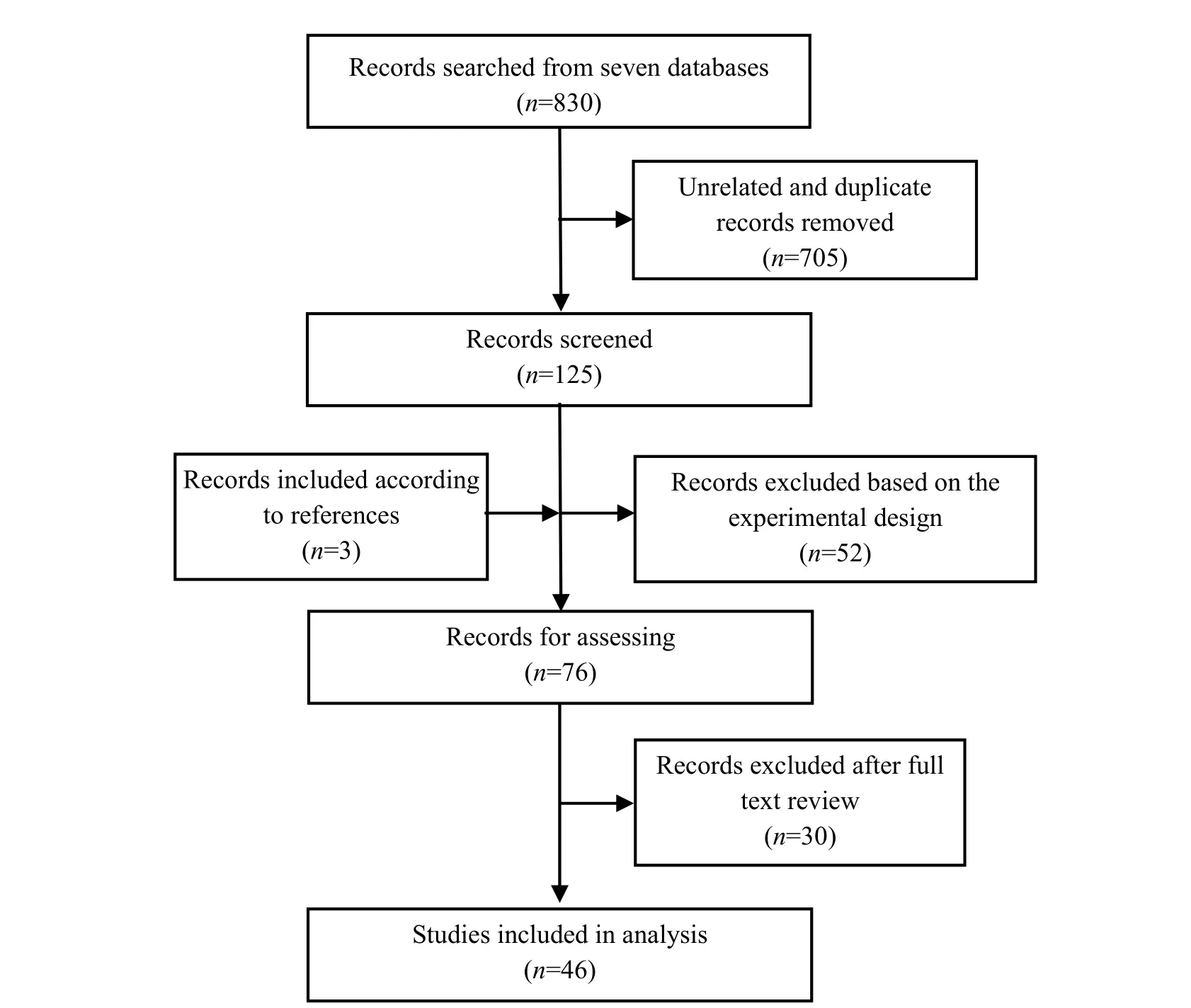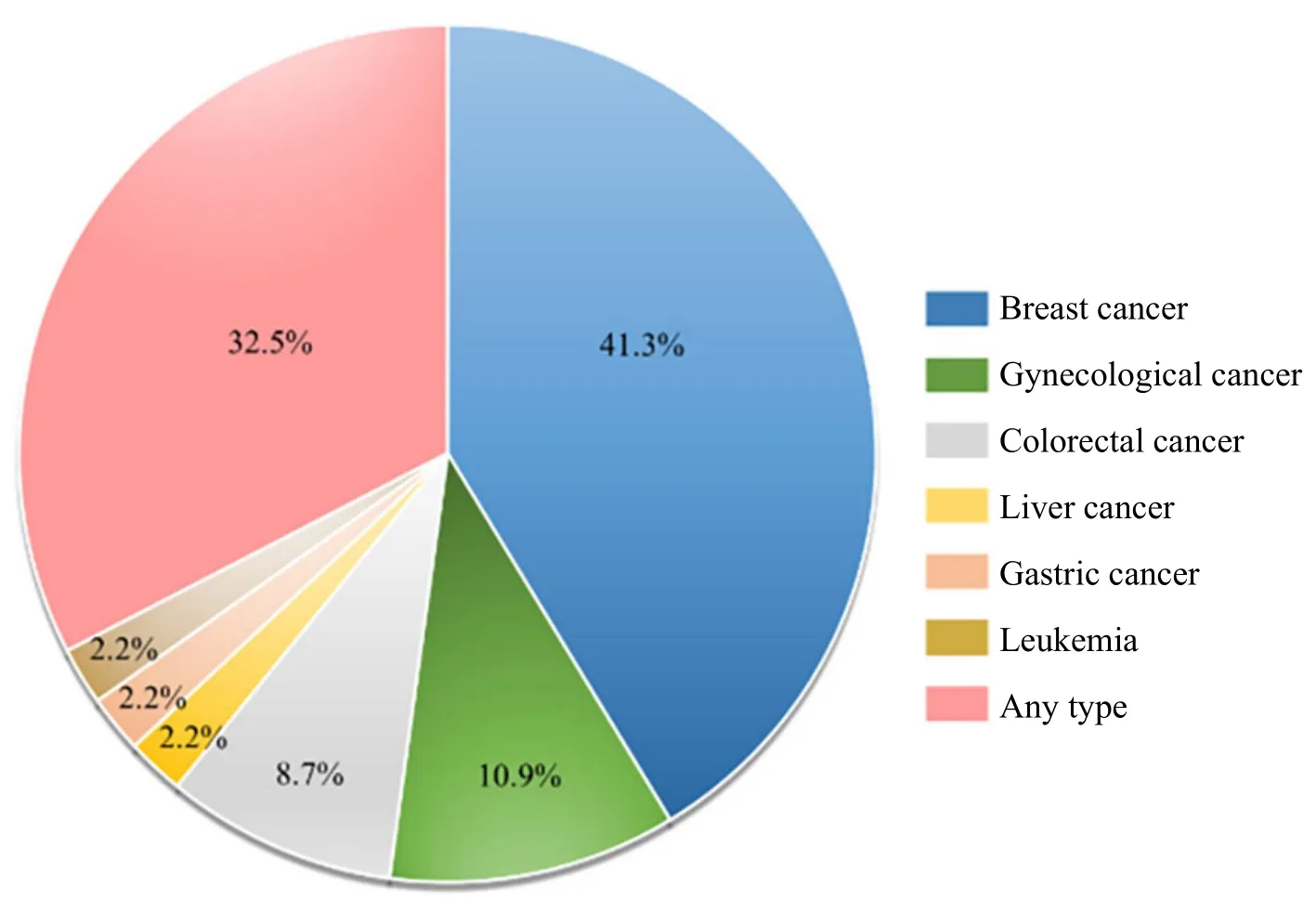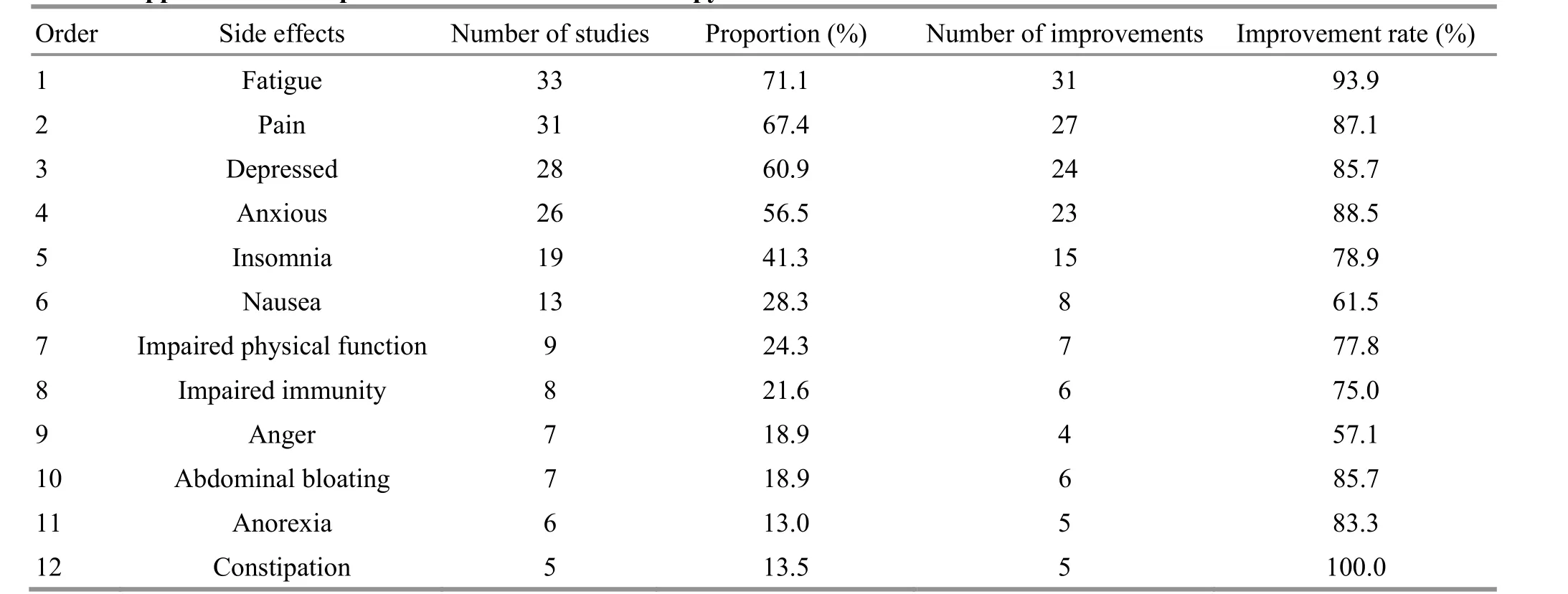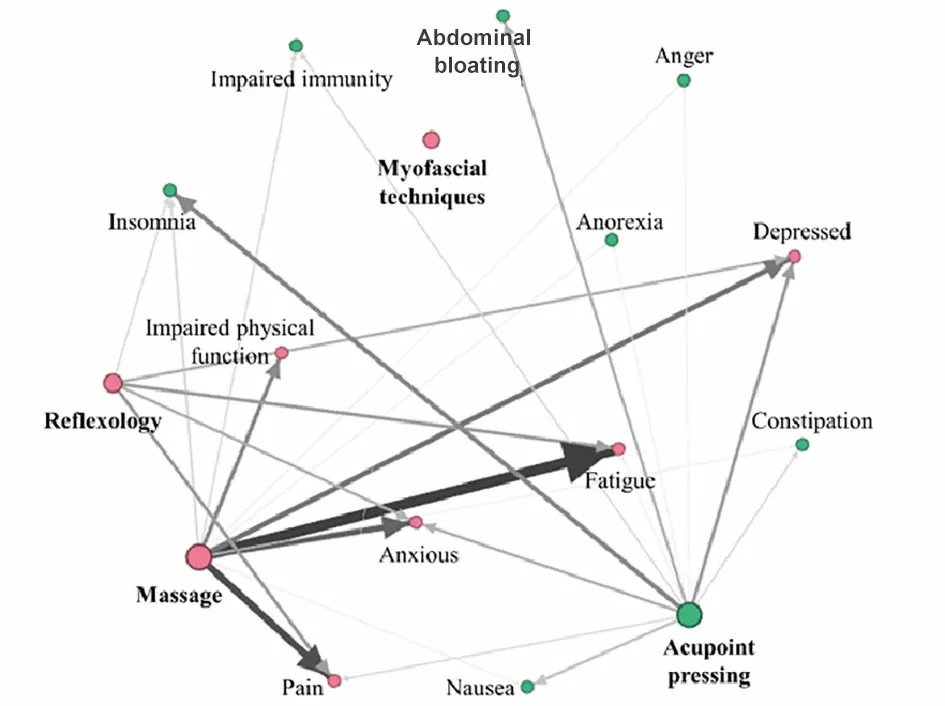Research on clinical application of manual therapy to tumor-related adverse reactions
2022-08-16YAOChongjie姚重界Zhizhen吕智桢ZHANGShuaipan张帅攀KONGLingjun孔令军ZHUQingguang朱清广CHENGYanbin程艳彬FANGMin房敏
YAO Chongjie (姚重界), LÜ Zhizhen (吕智桢), ZHANG Shuaipan (张帅攀), KONG Lingjun (孔令军),2,ZHU Qingguang (朱清广),2, CHENG Yanbin (程艳彬),2, FANG Min (房敏),2,3
Abstract
Keywords: Manual Therapies; Tuina; Massage; Acupoint Pressure Therapy; Reflexotherapy; Tumor; Adverse Reaction;Literature
With the rapid development of modern medicine,the cure rate of many diseases has been significantly increased, but tumor is still among the common diseases that threaten human health[1]. In China,although the increasing innovation of anticancer therapies and drugs has improved the survival rate of tumor patients by nearly 10.0%[2], many tumor-related diseases and adverse reactions caused by treatment do not allow the patients to improve their quality of life significantly. Clinical studies have suggested that more than 70.0% of tumor patients suffer from severe pain and fatigue[3-4]. Such symptoms as anxiety, depression and insomnia can bring them huge physical and psychological burdens. In addition, various adverse reactions can affect each other, giving rise to a vicious circle that severely impairs patients’ quality of life[5].
At present, the three-step analgesia program formulated by World Health Organization (WHO) is the main method adopted clinically to intervene the cancer-related pain[6], but the addiction and side effects resulting from this method are also severely challenging us[7]. Although methylphenidate seems to be the most promising in alleviating fatigue, the research results in recent years are controversial. Besides, as a psychotropic drug, methylphenidate may also lead to certain adverse reactions[8]. Therefore, tumor-related adverse reactions are mostly treated focusing on the symptoms, and it is difficult to find safe and effective intervention methods. In recent years, clinical studies have found that non-drug therapies, including Tuina(Chinese therapeutic massage), spinal manipulation,and acupuncture-moxibustion, can effectively relieve tumor-related adverse reactions[9-12]. With multi-targets,these therapies can alleviate multiple symptoms such as pain, fatigue, depression, and insomnia at the same time and benefit the recovery of postoperative organic functions.
Manual therapy (MT) is a representative of non-drug therapies, including Tuina, acupoint pressing,reflexotherapy, trigger point therapy, etc. As a traditional MT, Tuina has been widely used to treat internal and external diseases because of its remarkable curative effect[13-15]. Studies have found that MT can alleviate tumor patients’ physical and psychological discomfort and help the recovery of limb functions, thus improving their overall quality of life[16-17]. We summarized the research at home and abroad in recent years to analyze the clinical application of MT to tumor-related adverse reactions to provide a more theoretical basis for the clinical promotion of MT.
1 Materials and Methods
1.1 Literature sources
We searched seven databases. Chinese databases included China National Knowledge Infrastructure(CNKI), Wanfang Academic Journal Full-text Database(Wanfang) and Chongqing VIP Database (CQVIP).English databases included PubMed, Excerpta Medica Database (EMBASE), Ovid, and EBSCO. The publication date was between the establishment date of the database and December 31, 2020. The strategy of literature search in the Chinese databases included three parts: disease diagnosis (tumor or cancer),intervention methods (MT, Tuina, massage, acupoint pressing or acupoint massage), and literature types(clinical research). The literature was searched by title,keywords, or abstract. In the English databases, we searched keywords by MeSH, then searched the title or abstract of the expanded words, and limited the literature type to “clinical trial”. In addition, we reviewed the references of all relevant papers to ensure that no studies were missed.
1.2 Literature selection
1.2.1 Inclusion criteria
The literature fell under the clinical studies on MT intervention for tumor-related adverse reactions. The baseline data including age, gender, cancer type and duration of each group were consistent (P>0.05). The intervention measures in the eligible observation group could be such MT as Tuina, acupoint massage,reflexotherapy or trigger point therapy, and the control group was given routine treatment.
1.2.2 Exclusion criteria
Literature that presented unclear data expression,obvious mistakes or errors, and the inability of us to judge the outcome of the intervention. In addition to the MT interventions based on routine treatment, the observation group adopted other treatments such as acupuncture-moxibustion or Chinese medicinal herbs that might affect the results. In addition to routine treatment, the control group also adopted other intervention methods.
1.3 Literature processing
We numbered the literature obtained after the first search, then read the full text and selected the qualified clinical studies. We extracted the title, journal, author,publication date, cancer type, specific MT, related adverse reactions, and intervention results of the literature and entered this information into Excel. The key information required was presented in the form of figures or tables. We adopted Gephi 0.9.3 to analyze the correlation of effective interventions reported in different studies. Then we used modularization to process the imported data and visualize the data.
2 Results
2.1 Study inclusion
A total of 830 papers were retrieved from the seven databases. By reading their abstracts, we excluded the irrelevant and repetitive papers, and we selected 125 papers meeting the requirements. After reviewing the experimental design, we added three papers according to the references, and selected 76 papers from the 128 papers. Through reviewing the full text, we excluded 30 papers and eventually selected 46 papers,including 31 in English and 15 in Chinese. Check Figure 1 for details.

Figure 1. Flow chart of study selection
2.2 Application of MT to different tumors
Literature statistics showed that 19 studies in the 46 included papers studied MT intervention for breast cancer-related adverse reactions, accounting for 41.3%of all the studies. Five studies were related to gynecological cancer, accounting for 10.9%.Gastrointestinal tumors, including colorectal cancer,gastric cancer, and liver cancer, accounted for 13.1%.And one study was on leukemia. In addition, 15 studies involved tumors of unlimited types, including the above types of cancer and lung cancer, bladder cancer, and lymphatic cancer. Check Figure 2 for details.
2.3 Specific situation of MT application to tumor-related adverse reactions
Literature statistics showed that among the 46 included papers, 33 studies focused on fatigue,accounting for 71.1% of all the studies. Among the 33 studies, 31 suggested that fatigue was significantly relieved after intervention compared with the control group (P<0.05), accounting for 93.9%. The following adverse reactions were pain, depression and anxiety,insomnia, nausea, limb dysfunctions, low immune function, anger, abdominal bloating, poor appetite, and constipation. The number of studies reporting significant improvement in nausea and anger (P<0.05)was smaller than 65.0% of the relevant studies, and the number of studies reporting improvement of other adverse reactions accounted for more than 75.0% of the relevant studies. Constipation was significantly improved in all the relevant studies compared with the control group (P<0.05). Check Table 1 for details.
2.4 Application of different MT to tumor-related adverse reactions
We matched different methods of MT with the adverse reactions that were effectively treated by the very methods and conducted a correlation analysis. The results showed that Tuina, reflexotherapy, and acupoint pressing were the common methods for MT in clinical research. Myofascial release was rarely adopted in such studies, and there was only one study that adopted this method. The results showed that the intervention relieved such symptoms as pain, poor appetite, and depression[18]. Tuina was mainly adopted to intervene against such tumor-related adverse reactions as fatigue,pain, anxiety, depression, and limb dysfunctions.Acupoint pressing was adopted to intervene in various symptoms that were mostly gastrointestinal and psychological problems such as abdominal bloating,insomnia, depression, and anxiety, and its application to insomnia was more than other methods for MT. The relevant reports of reflexotherapy were all from foreign studies. The intervened symptoms were similar to those of Tuina, but the overall clinical application could not bear comparison with Tuina and acupoint pressing.Check Figure 3 for details.

Figure 2. Application of MT to different tumors

Table 1. Application and improvement rate of manual therapy for various tumor-related adverse reactions

Figure 3. Application of different manual therapies to tumor-related adverse reactions
2.5 Analysis of the clinical application of MT to tumor-related adverse reactions
2.5.1 MT can relieve the somatic adverse reactions
The somatic adverse reactions in this study included fatigue, pain, insomnia, nausea, abdominal bloating,poor appetite, and constipation. Clinical studies have suggested that nausea, poor appetite, and even vomiting caused by chemotherapy are common adverse reactions that can affect both the quality of life and the treatment efficacy[19-20]. Therefore, these problems must be solved from the perspectives of prevention and treatment. ZHOU L L,et al[21]performed acupoint pressing on the leukemia patients’ Neiguan (PC6), Hegu(LI4), and Zusanli (ST36) before the patients received chemotherapy, which effectively alleviated nausea caused by chemotherapy. COLLINGE W,et al[22]relieved nausea in tumor patients through Tuina. Fatigue and pain, as two common adverse reactions in tumor patients, can be induced by surgery, tumor,radiotherapy, or chemotherapy. They can be significantly relieved through MT interventions. By reflexotherapy, DIKMEN H A,et al[23]relieved the pain and fatigue in gynecological cancer patients during chemotherapy. Through Thai massage, KHIEWKHERN S,et al[24]alleviated the pain and fatigue in colorectal cancer patients undergoing chemotherapy. However,some studies have shown that reflexotherapy cannot effectively relieve the pain in patients with advanced breast cancer but can relieve their fatigue[25]. Insomnia was mainly intervened by acupoint pressing. YE W J,et al[26]performed acupoint pressing on the upper limb acupoints of the patients after a breast cancer operation, and WU H,et al[27]performed acupoint pressing on the reflection area of hands and feet of the malignant tumor patients, both of which improved the sleep quality of the patients.
2.5.2 MT can improve the psychological state
The psychological problems in this study included depression, anxiety, and anger. A study reporting on mood disorders in breast cancer patients intervened by Tuina[28]. It was not included in this study since only one study was not sufficient, and the data were not clear.Depression and anxiety, as common psychological problems in cancer patients, usually occur at the same time and can be relieved after intervention. In this study,all the three MTs, including Tuina, acupoint pressing,and reflexotherapy could alleviate these two psychological problems. WILKINSON S M,et al[29]alleviated the anxiety and depression in cancer patients by Tuina. NOH G O,et al[30]adopted reflexotherapy to treat gynecologic tumor patients receiving chemotherapy. LIU Y H,et al[31]adopted acupoint massage to treat perioperative patients with breast cancer, all of which relieved patients’ anxiety and depression. DONOYAMA N,et al[32]adopted Japanese massage to intervene gynecological cancer patients after operation, which did not significantly relieve patients’ anxiety and depression, but alleviated patients’ anger.
2.5.3 MT can improve the overall functions of patients
The limb functions and immune functions in this study were used to evaluate the functional status of patients. Studies have shown that the occurrence and development of tumors are closely related to immune functions, and natural killer (NK) cells are one of the immune cells with the strongest anticancer activity in the human body[33]. Tumor patients may suffer from some immune dysfunctions. Radiotherapy and chemotherapy may improve the level of inflammatory factors in the peripheral blood of tumor patients, but may further impair their immune functions[34]. By acupoint pressing, WAN X M,et al[35]increased the patients’ CD4+T cells and NK cells, and decreased their CD8+T cells, thus regulating the immune functions of the patients. BILLHULT A,et al[36]treated breast cancer patients receiving radiotherapy by Tuina, which significantly improved the reduced activity of NK cells during radiotherapy. BEURSKENS C H,et al[37]intervened with breast cancer patients after axillary dissection by Tuina, which improved patients’ quality of life, significantly increased their shoulder joints’ range of motion and, and thus enhance their limb functions.
3 Discussion
As a representative of non-drug therapy, MT has been widely used across the world and plays a crucial role in treating pain, depression, and autoimmune diseases[38]. Tumors, among the main conditions threatening human health, can bring patients various adverse reactions. And these adverse reactions may also present in the process of tumor treatment. They not only influence patients’ health but also lead to psychological problems, severely impairing patients’quality of life. At present, symptomatic treatment is the main method in clinical settings, but patients often experience various adverse reactions, and thus the treatment effect is limited[5]. Consequently, the National Comprehensive Cancer Network of the United States has included a variety of non-drug therapies in the guidelines for dealing with tumor-related adverse reactions, and MT is included[9].
In this study, MT was widely used in breast cancer patients. Tuina, acupoint pressing, and reflexotherapy were the most widely adopted MT interventions. The methods of massage in this paper included Tuina, Thai massage, Japanese massage, Swedish massage, etc.Though their theoretical basis is different, they are similar in the main techniques, so it is difficult to completely distinguish them. Among them, Tuina was mainly used in domestic research, while Thai massage and Swedish massage were mainly used in foreign research. Fatigue, pain, depression, and anxiety, as the most common adverse reactions in this study, could be significantly relieved under the intervention of Tuina,which could improve patients’ quality of life.
Acupoint pressing, with a distinctive Chinese feature,can dredge the meridians, regulate qi and blood, and thus effectively alleviate the symptoms of the digestive system and psychological problems[39]. As the main MT intervention in foreign countries, reflexotherapy achieves the therapeutic effect mainly by pressing the corresponding reflection area on the feet[40]and plays a significant role in the rehabilitation nursing of chronic diseases.
In addition, this study has found that MT was rarely performed by professional doctors in intervening in tumor-related adverse reactions. In China, it was mainly operated by nurses, while in foreign countries, it was mainly operated by nurses, therapists or trained volunteers. Therefore, in these reported studies, the manipulation of Tuina was relatively simple, and acupoint pressing and reflexotherapy accounted for a large proportion of MT since they were easy to operate.After summarizing and analyzing the existing research results, we have found that MT can be promoted as an important non-drug therapy to alleviate various adverse reactions. However, at present, the clinical application of MT to tumors is relatively limited, and there are still some problems involving this therapy. Firstly, there is no unified operation standard for each symptom, and the non-standard operation also contributes to the low repeatability of research. In addition, professional doctors engaged in this field are not enough, a unified efficacy evaluation standard has not been established,and the relevant basic research is insufficient. Therefore,more in-depth research in relevant fields is needed in the future.
In summary, MT can alleviate various types of adverse reactions by relieving patients’ somatic symptoms and improving their psychological states as well as overall functions. It can be popularized as important non-drug therapy. At present, however, the clinical application of MT is neither extensive nor has sufficient basic research. Therefore, we should attach importance to this application.
Conflict of Interest
There is no potential conflict of interest in this article.
Acknowledgments
This work was supported by Projects of National Natural Science Foundation of China (国家自然科学基金项目,No. 82030121, No. 81973973, No. 82004493); Graduate Student Innovation Ability Project of Shanghai University of Traditional Chinese Medicine (上海中医药大学研究生创新培养专项, No. Y2020017).
Received: 13 December 2020/Accepted: 9 June 2021
猜你喜欢
杂志排行
Journal of Acupuncture and Tuina Science的其它文章
- Observation on efficacy of thumbtack needle combined with pediatric Tuina for constipation in children caused by liver depression and Qi stagnation
- Clinical study on Tuina plus physical agents for lateral collateral ligament injury of ankle in gymnasts
- Efficacy of knee-balancing manipulation plus heat-sensitive moxibustion for knee osteoarthritis and its influence on CTX-Ⅰ, TRACP-5b,ADAMTS-4, and MMP-3
- Clinical observation of warm needling moxibustion plus lumbar traction for lumbar disc herniation
- Clinical observation of acupuncture plus acupoint sticking therapy for insomnia and its influence on subjective and objective sleep indicators
- Effects of acupuncture on nutritional status in patients in a persistent vegetative state:a prospective randomized controlled study
